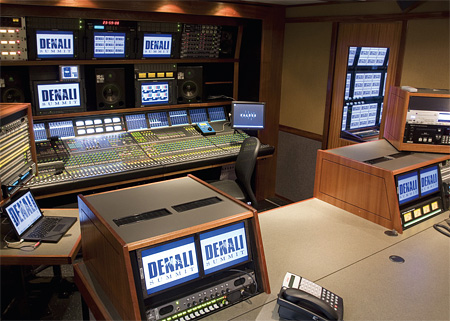Trucks: A Most Unfriendly Audio Environment
LOS ANGELES—Space and weight are obviously critical limitations for consideration when designing and building audio control rooms for mobile production vehicles. But the overriding challenge for any designer is noise—both internal and external.
"You can't reference if you don't have a decent background noise floor to work with," noted Russ Berger, president of Russ Berger Design Group an Addison, Texas-based audio design and consulting firm. "The single most important thing you can do in a truck is try and create a quiet environment and eliminate, as much as you can, any internal noises."

The audio room in NE P's Denali Summit, which launched in 2008, is configured for large entertainment programs. While the size and efficacy of the onboard air conditioning may be limited by the weight restrictions imposed on the vehicle, designers can at least attenuate the noise it creates, Berger noted. There are methods to reduce the noise of the compressors and air handlers and, of course, the a/c unit should be located as far as possible from the audio room.
But that potential noisemaker pales somewhat in comparison to a larger challenge, according to George Hoover, CTO with teleproduction services provider NEP Broadcasting. "The biggest complaint we hear from mixers is trying to keep all of the equipment that has fans, and that they want to have near them, quiet."
In the sports world, in particular, said Hoover, the mixer may be the sole audio guy. "In his room he needs patching, distribution, processing and the console, and oftentimes there's no room to keep all those noisy things out of the way."
On his wish list for the ideal room design, said Kevin Cleary, senior technical audio producer for ESPN, "Number one is getting all of the large, fanned, noisemaking, core-type devices—whether they be router cores or ADAM frames—and moving them into a machine room, or into someplace else where listening is not as critical."
With the space limitations in trucks, positioning certain pieces of equipment in the audio room might not be the best choice, Cleary noted. "You wouldn't put a skylight in the video control room, so why would you put a large, noisy thing in the audio control room?"
As for controlling noise transmission, "When you talk about sound isolation you're talking about mass," said Berger, who noted that the weight available for isolation treatment on any given vehicle can be calculated. "The goal is to get even, broadband noise control. We go as far as we can based on the weight limits."
"We typically use heavy lead-backed lining in the audio rooms on all the walls," Hoover said. "But you can't put an acoustical door in; you can't sustain the weight and dimensionality."
MAKING DO
Space is always at a premium and by necessity, compromises must be made when allocating space for the audio room.
"You're competing not only for the video portion of the technology but also all of the production people that physically need to get into this mobile unit," said Hoover.
In trucks handling entertainment events, "The audio rooms are purposely built much larger because they have to accommodate more equipment and more people," he said. In contrast, "In most typical sports trucks you're working with whatever is left over."
But room dimensions are just one variable in the equation, explained Berger. "You have the volume—the ratios of height, length and width—of the space, the shape of the space and the finishes." Ideally, said Berger, "the operator is positioned on the central axis of the room and the room is longer than it is wide. They want to be at least 10 feet away from the back wall—which you can't achieve, so you have to find a way to make the back wall disappear acoustically, so it has minimal impact on the mix."
In order to achieve greater volume in a truck audio room that he recently designed for MTV in Nashville, Berger utilized what he calls "leaky wall technology." This allows low frequencies to be vented into an adjacent space—in this case, the vehicle's belly pan storage. "We're looking for some serious extension in the low end by effectively increasing the apparent volume of the space and therefore improving the accuracy at frequencies below the lower range of the male voice," he elaborated.
In a truck, where every square inch is needed for something, controlling anything through shape is a non-starter, continued Berger. "Shaping typically is where you control flutter echoes and redirect energy into treatments and other areas of the room. So that has to be controlled through finishes."
Cleary reported that he and his audio crews have even had occasion to modify a truck's audio room acoustics: "We've put in different treatments to make the room sound better, whether it be curtains or flat panels or other materials."
Equipment placement is another critical factor, Hoover commented. "You can't take the center speaker and raise it six inches above your head and move it a foot and a half forward so you can put the program monitor down low, then expect to have a mix that accurately reflects anything that's going on in the world."
Get the TV Tech Newsletter
The professional video industry's #1 source for news, trends and product and tech information. Sign up below.
Steve Harvey began writing for Pro Sound News and Surround Professional in 2000 and is currently senior content producer for Mix and a contributor to TV Tech. He has worked in the pro audio industry—as a touring musician, in live production, installed sound, and equipment sales and marketing—since November 1980.
